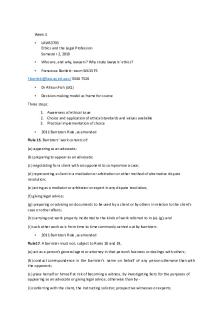Fates of pyruvate - Lecture notes 37-40 PDF

| Title | Fates of pyruvate - Lecture notes 37-40 |
|---|---|
| Course | Introductory Biochemistry |
| Institution | University of Alberta |
| Pages | 4 |
| File Size | 194 KB |
| File Type | |
| Total Downloads | 54 |
| Total Views | 154 |
Summary
Jonathan Parrish...
Description
Fates of pyruvate Pyruvate is the last product of glycolysis. The three immediate metabolic fates of pyruvate are: 1. Converted to ethanol (anaerobic) 2. Converted to lactate (anaerobic) 3. Converted to Acetyl CoA Anaerobic fates for pyruvate is important because NAD+ needs to be regenerated for glycolysis to take place in anaerobic conditions. Lactate form in muscle cells, and ethanol in yeast cells through a process called fermentation.
The production of lactate:
Lactate is not an acid It is a dead-end product in skeletal muscles during anaerobic activity A membrane transporter protein transports the lactate out of the muscle and into the blood. The pH of the blood is lowered, O2 is released from hemoglobin Muscle cell gets more oxygen Under aerobic conditions, lactate is a metabolic fuel for cardiac tissue
Hydrolysis of ATP by myosin produces hydrogen which can cause acidotic damage to muscle fibres, not lactate. ATP + H2O → ADP + Pi + H+
The production of ethanol:
Does not occur in vertebrates Occurs in yeast Pyruvate is decarboxylated and reduced to form ethanol In the process one molecule of CO2, NAD+ and ethanol is produced
Production of Acetyl-CoA:
Acetyl CoA links glycolysis to the citric acid cycle. The conversion of pyruvate to acetyl CoA happens in the mitochondrial matrix The reaction is catalysed by pyruvate dehydrogenase complex
Transportation of pyruvate from cytosol to mitochondrial matrix:
Pyruvate passes through porins in the outer membrane of the mitochondria Pyruvate passes through the transport protein pyruvate translocase in the inner membrane of the mitochondria Pyruvate translocase is a symport. A proton also enter matrix with the pyruvate molecule.
Conversion of pyruvate to Acetyl CoA:
It is converted via the pyruvate dehydrogenase complex One molecule of CO2 and NADH is also generated in the process Acetyl- CoA is a Coenzyme A bonded to acetyl group with a thioester bond CoA is a derivative of vitamin B5 linked to an adenosine nucleotide. Its functional group is SH (thiol) The formation of acetyl-CoA is irreversible in carbohydrate metabolism It is reversible in lipid metabolism The pyruvate dehydrogenase reaction requires 5 cofactors including NAD+, FAD and CoA It is an example of oxidative decarboxylation Pyruvate hydrogenase is a multi-enzyme complex (3 catalytic enzymes) (speeds up reaction time, limits number of side reaction, enzyme controlled as single unit) Acetyl CoA is a high energy intermediate
Regulation of pyruvate dehydrogenase: 1. NAD+/NADH: NADH inhibits PDH by protein kinase activation (phosphorylation of PDH, allosteric) 2. Acetyl Co-A: Inhibitor, activates protein kinase (phosphorylation of PDH) 3. Ca2+: Activator, dephosphorylates PDH protein phosphatase activation) PDH is regulated by reversible phosphorylation. It is switched off when energy level is very high (Ratio of ATP/ADP is high). Phosphorylation of PDH witches off its activity and vise versa. Protein kinase is responsible for phosphorylation of PDH. Protein kinase is activated by NADH and acetyl CoA. It is inhibited by NAD+, pyruvate and ADP....
Similar Free PDFs

Lecture Notes of COMP2300
- 42 Pages

Summary of lecture notes
- 4 Pages

Lecture notes, Mistake of Fact
- 5 Pages

Lecture Notes - Duty of care
- 2 Pages

Exam 1 Notes of Lecture
- 37 Pages
Popular Institutions
- Tinajero National High School - Annex
- Politeknik Caltex Riau
- Yokohama City University
- SGT University
- University of Al-Qadisiyah
- Divine Word College of Vigan
- Techniek College Rotterdam
- Universidade de Santiago
- Universiti Teknologi MARA Cawangan Johor Kampus Pasir Gudang
- Poltekkes Kemenkes Yogyakarta
- Baguio City National High School
- Colegio san marcos
- preparatoria uno
- Centro de Bachillerato Tecnológico Industrial y de Servicios No. 107
- Dalian Maritime University
- Quang Trung Secondary School
- Colegio Tecnológico en Informática
- Corporación Regional de Educación Superior
- Grupo CEDVA
- Dar Al Uloom University
- Centro de Estudios Preuniversitarios de la Universidad Nacional de Ingeniería
- 上智大学
- Aakash International School, Nuna Majara
- San Felipe Neri Catholic School
- Kang Chiao International School - New Taipei City
- Misamis Occidental National High School
- Institución Educativa Escuela Normal Juan Ladrilleros
- Kolehiyo ng Pantukan
- Batanes State College
- Instituto Continental
- Sekolah Menengah Kejuruan Kesehatan Kaltara (Tarakan)
- Colegio de La Inmaculada Concepcion - Cebu










